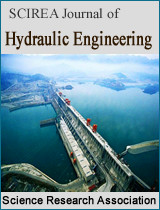THE INFLUENCE OF VARIATION OF WEIR CREST SHAPE WITH USBR-I TYPE OF STILLING BASIN ON THE LENGTH OF HYDRAULIC JUMP AND LOSS OF ENERGY
DOI: 10.54647/hydraulic57013 106 Downloads 7747 Views
Author(s)
Abstract
The Crest of weir is an important part of dam construction because the function is releasing water from the upstream part of the dam. The effect of a dam can create supercritical flow (supercritical) downstream of the weir and cause a water jump (hydraulic jump) which if left untreated will occur local scour the downstream. weir. In weir planning, it is necessary to take into the dam will be used because it affects the flow conditions downstream of the weir. This research was conducted by making variations in the form of test objects, namely ogee crest weirs, 1 radius round type weirs, and 2 radius round type weirs using the USBR-I stilling basin type which was then tested in the laboratory using five different variations of flow rates, namely 3000 cm3/s, 3500 cm3/s, 4000 cm3/s, 4500 cm3/s, and 5000 cm3/s. The data test was analyzed to obtain results of research and compared with the crest variations to find the best efficient to reduce energy and length of hydraulic jump. The results in the study show the effect of dam crest variations on the length of the hydraulic jump (Lj) based on the maximum discharge, which is round type 1 radius of dam crest with 125 cm longest Lj, then a 2 radius round type with the longest Lj 136 cm, and an ogee type with the longest Lj. 142 cm. For the effect of variations of dam crest on energy loss (hf), the average value of the five running discharge experiments on each specimen was taken, the variation of the dam crest that had the greatest to the smallest energy loss (hf) value was the 2 radius round type dam with hf average 31,429 cm, ogee type dam with an average hf of 31.404 cm, and round type 1 radius dam with an average hf of 30.456 cm. So it can be concluded based on the results of the analysis for the variation of the dam crest that is the most efficient in reducing energy is the 2 radius round type dam crest.
Keywords
crest of weir, hydraulic jump, energy loss
Cite this paper
Jaji Abdurrosyid, Edi Purwanto, Renaningsih,
THE INFLUENCE OF VARIATION OF WEIR CREST SHAPE WITH USBR-I TYPE OF STILLING BASIN ON THE LENGTH OF HYDRAULIC JUMP AND LOSS OF ENERGY
, SCIREA Journal of Hydraulic Engineering .
Volume 4, Issue 1, February 2021 | PP. 1-20.
10.54647/hydraulic57013
References
| [ 1 ] | Abdurrosyid, Jaji, et.all. 2018. “Influence of Baffle Block and Weir Downstream Slope at Stilling Basin of Solid Roller Bucket Type on Hydraulic Jump and Energy Dissipation”. AIP Conference Proceedings 1977, 040031 (2018); https://doi.org/10.1063/1.5043001 |
| [ 2 ] | Abdurrosyid, Jaji dan Pratiwi P D. 2020. “Kajian Pengaruh Slotted dan Baffle Blocks pada Kolam Olak Roller Bucket Terhadap Peredam Energi”. Jurnal Dinamika Teknik Sipil, Vol 3, No 1 (2020): 1-9; http://journals.ums.ac.id/index.php/DTS/issue/view/1063 |
| [ 3 ] | Risman, dkk. 2017. “Kajian Perilaku Aliran Melalui Alat Ukur Debit Mercu Bulat Terhadap Tinggi Muka Air”. Skripsi. Semarang: Fakultas Teknik, Politekhnik Negeri Semarang. |
| [ 4 ] | Ihsan, M. Kabir, 2017. “Pengaruh Bentuk Mercu Bendung Terhadap Tinggi Loncat Air Kolam Olak Model USBR IV (Simulasi Laboratorium)”. Teras Jurnal, Vol 7, No 1 (2017) : 173-182. |
| [ 5 ] | Nurjanah, R.A Dita. 2014. “Analisis Tinggi dan Panjang Loncat Air pada Bangunan Ukur Berbentuk Setengah Lingkaran”. Skripsi. Sumatera Selatan: Fakultas Teknik, Universitas Sriwijaya. |
| [ 6 ] | Irrigation Planning Standards/ Standar Perencanaan Irigasi (KP-02), 2015. Kriteria Perencanaan Bagian Bangunan Utama. Jakarta: DPU, Dirjen Pengairan. |
| [ 7 ] | Novak, P., et.al. 1996. Hydraulic Structure. Oxford : Alden Press. |
| [ 8 ] | Abdurrosyid, Jaji dkk. 2009. “Studi Gerusan dan Perlindunganya di Hilir Kolam Olakan Bendung Tipe USBR-I”. Jurnal Dinamika Teknik Sipil, Terakreditasi BAN, Vol 9, No 1 (2009) : 27-37 |
| [ 9 ] | USBR, 1987. Design of Small Dams. 3rd ed., Denver: US Government Printing Office. USA. |
| [ 10 ] | Kharagpur, 1995. Hydraulic Structures for Flow Diversion and Storage, New Delhi: CE IIT, version 2. |
| [ 11 ] | http://web.iku.edu.tr/~asenturk/Microsoft PowerPoint-open-channel1.pdf |

